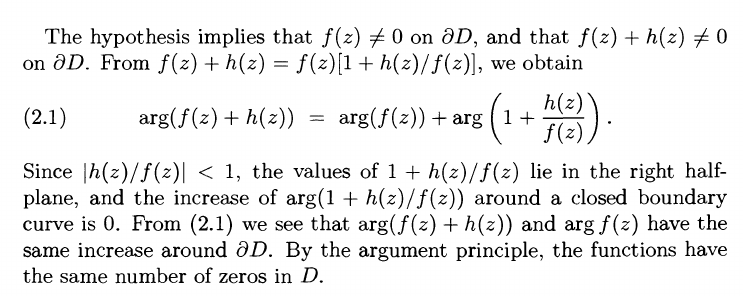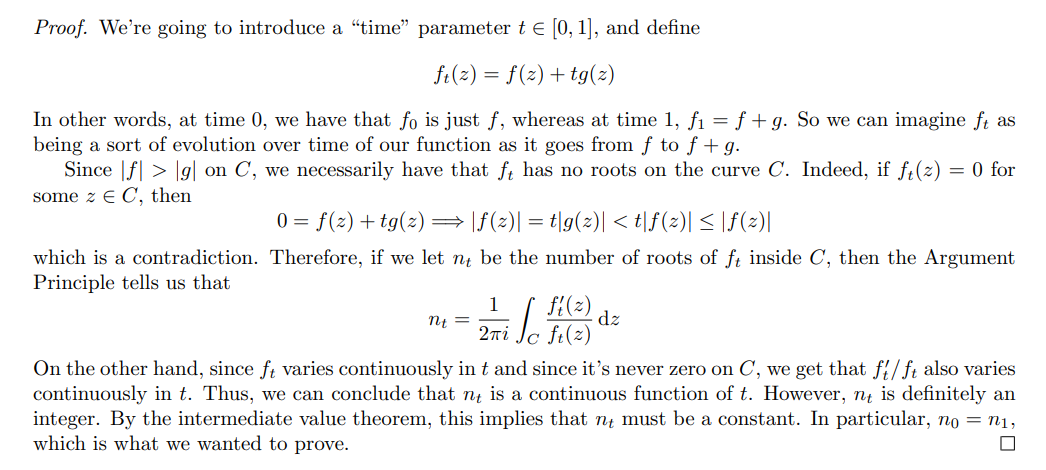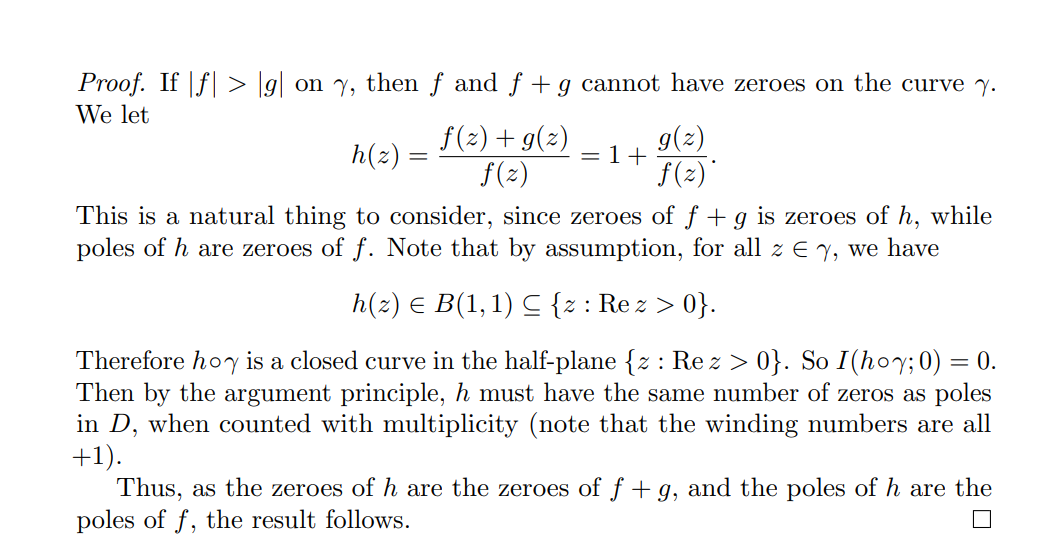Let \(M, m\) be meromorphic on \(\Omega\) and write \(Z_M, Z_m, P_M, P_m\) for the numbers of zeros and poles of \(M\) and \(m\) respectively. Suppose \(\gamma \subseteq \Omega\) is a toy contour winding about each zero and pole of \(f\) and \(g\) precisely once. Then \begin{align*} {\left\lvert {m} \right\rvert} \leq {\left\lvert {M} \right\rvert} \text{ on } \gamma \implies \mathop{\mathrm{Index}}_{z=0}(M\circ \gamma)(z) &= \mathop{\mathrm{Index}}_{z=0}((M+m)\circ \gamma)(z) \\ \implies Z_M - P_M &= Z_{M+m} - P_{M+m} .\end{align*} In particular, if \(M, m\) are holomorphic on \(\Omega\), then \(M\) and \(M+m\) have the same number of zeros in \(\Omega\), i.e. \(Z_M = Z_{M+m}\).
The number of zeros/poles in a region is determined by a dominating function on the boundary. You can add a small perturbation \(m\) to \(M\) and preserve the number of zeros, where “small” means \({\left\lvert {m} \right\rvert} < {\left\lvert {M} \right\rvert}\) on the boundary.
On how to use Rouché, and some common tricks:
-
Given \(f\) and a region, find a big part \(M\) and a small part \(m \coloneqq f-M\). Then show \({\left\lvert {m} \right\rvert} < {\left\lvert {M} \right\rvert}\) to get \({\sharp}Z_M = {\sharp}Z_f\).
- It should also be clear how many zeros \(M\) has in the region!
- Given \(f\), just find a large part \(M\), and show \({\left\lvert {f-M} \right\rvert} < M\).
- Given \({\left\lvert {m} \right\rvert} < {\left\lvert {M} \right\rvert}\) with no ambient \(f\), you can freely choose \(f\) to be any of \(\pm (M \pm m)\) to obtain \(Z_M = Z_f\)
-
Given \(f\) and \(g\), show \({\left\lvert {f-g} \right\rvert} < {\left\lvert {f} \right\rvert}\) to get \(Z_f = Z_g\).
- This can be improved to \({\left\lvert {f-g} \right\rvert} < {\left\lvert {f} \right\rvert} + {\left\lvert {g} \right\rvert}\) using the symmetric/extended version of the theorem.
- A common trick: show \({\left\lvert {f-g} \right\rvert} < 1\) and either \({\left\lvert {f} \right\rvert} > 1\) or \({\left\lvert {g} \right\rvert} > 1\).
- For power series \(f_n(z) \to f(z)\): find a lower bound \(L\) for \(f\) and an upper bound for the tail \(f - f_n\) to get \({\left\lvert {f_n - f} \right\rvert} < U < L < {\left\lvert {f} \right\rvert}\) to get \(Z_f = Z_{f_n}\).
Idea: use argument principle on \((f+g)/f\). Alternatively, use that \(N(f+tg, \Omega)\) is a continuous \({\mathbb{Z}}{\hbox{-}}\)valued function for all \(t\in [0, 1]\).



Exercises
Find the number of zeros in \({\left\lvert {z} \right\rvert} < 1\) of \begin{align*} p(z) \coloneqq z^6 + 9z^4 + z^3 + 2z + 4 .\end{align*}
Strategy: bound the difference. Find the big and small term:
- Big: \(F(z) = 9z^4\), so \({\left\lvert {F(z)} \right\rvert} = 9\) on the boundary
- Small: \(g(z) = p(z) - F(z) = z^6 + z^3 + 2z + 4\), so \({\left\lvert {g(z)} \right\rvert}\leq 1+1+2+4=8\) on the boundary.
So \({\left\lvert {p-F} \right\rvert} \leq {\left\lvert {F} \right\rvert}\) on \({\left\lvert {z} \right\rvert} = 2\), meaning \(Z_{p} = Z_F = 4\).
Find the number of zeros in \({\left\lvert {z} \right\rvert} < 2\) of \begin{align*} h(z) \coloneqq z^5 + 3z + 1 .\end{align*}
Strategy: bound the difference.
- Big: \(F(z) \coloneqq z^5\) so \({\left\lvert {F(z)} \right\rvert} = 2^5 = 32\) on \({\left\lvert {z} \right\rvert} = 2\)
- Small: \(g(z) \coloneqq p(z) - F(z) = 3z+1\), so \({\left\lvert {g(z)} \right\rvert} \leq 3{\left\lvert {z} \right\rvert}+ 1 = 7\) on \({\left\lvert {z} \right\rvert} = 2\).
Then \({\left\lvert {g} \right\rvert}\leq {\left\lvert {F} \right\rvert}\) on \({\left\lvert {z} \right\rvert} = 2\), \(Z_{p} = Z_F = 5\).
Find the number of zeros in \({\left\lvert {z} \right\rvert} < R\) of \begin{align*} p(z) \coloneqq z^d + a_1z^{d-1} + \cdots + a_d ,\end{align*} supposing that \({\left\lvert {a_k} \right\rvert}< {R^k \over d}\) for every \(k\) (noting the strict inequality).
Strategy: bound the difference. Find the big and small term:
- Big: \(F(z) = z^d\), so \({\left\lvert {F(z)} \right\rvert} = R^d\) on \({\left\lvert {z} \right\rvert} = R\).
- Small: \(g(z) = p(z) - F(z) = a_1 z^{d-1} + \cdots + a_d\), so \begin{align*} {\left\lvert {g(z)} \right\rvert} &\leq {\left\lvert {a_1} \right\rvert} R^{d-1} + {\left\lvert {a_2} \right\rvert} R^{d-2} + \cdots + {\left\lvert {a_d} \right\rvert} \\ &< {R\over d} \cdot R^{d-1} + {R^2 \over d} \cdot R^{d-2} + \cdots + {R^{d-1} \over d} \cdot R + {R^{d} \over d} \\ &= d {R^d\over d} = R^d ,\end{align*} so \({\left\lvert {g} \right\rvert} < R^d = {\left\lvert {F} \right\rvert}\), meaning \(Z_{p-F} = Z_F = d\) in \(R{\mathbb{D}}\).
Find the number of solutions in \(\left\{{\Re(z) \leq 0}\right\}\) of \begin{align*} -2e^z = z+3 .\end{align*}
Hint: show \(h(z) = z + 3 + 2e^z\) has one root in \(\left\{{ \Re(z) \leq 0}\right\}\).
Note that \({\left\lvert {e^z} \right\rvert} = e^{\Re(z)} \leq e^{0} = 1\) since \(\Re(z) \leq 0\), so if the equality holds then \begin{align*} {\left\lvert {2e^z} \right\rvert} = {\left\lvert {z+3} \right\rvert} \implies {\left\lvert {z+3} \right\rvert}\leq 2 .\end{align*} So apply Rouché to \(\Omega\) the circle of radius 2 centered at \(z=-3\). Write \(p(z) \coloneqq z+3 + 2e^z\), then
- Big: \(F(z) = z+3\), so \({\left\lvert {F(z)} \right\rvert} = 2\) on \({{\partial}}\Omega\).
- Small: \(g(z) = 2e^z\), so \({\left\lvert {g(z)} \right\rvert} = 2e^{\Re(z)} < 2\) in \(\Omega\).
Then \(Z_p = Z_F = 1\), and any such zero is a solution to the original equation.
Use the following region:

Consider \(p(z) \coloneqq z+3+2e^z\), take \(F(z) \coloneqq z+3\) and \(h(z) \coloneqq 2e^z\) for the perturbation. On \(C_1, z=it\) for \(t\in [-R, R]\), so \begin{align*} {\left\lvert {F(z)} \right\rvert} &= {\left\lvert {3+it} \right\rvert} \geq 3 \\ {\left\lvert {h(z)} \right\rvert} &= 2e^{\Re(iy)}=2 ,\end{align*} so \({\left\lvert {h} \right\rvert} < {\left\lvert {F} \right\rvert}\) here. On \({\left\lvert {z} \right\rvert} = R\), \({\left\lvert {h(z)} \right\rvert} < 2e^{\Re(z)} < 2\) since \(\Re(z) < 0\), and \({\left\lvert {F(z)} \right\rvert} = { \mathsf{O}} (R)\), so for \(R\gg 1\) we have \({\left\lvert {F} \right\rvert} > {\left\lvert {h} \right\rvert}\) here too.
Thus \(Z_{h+F} = Z_f = 1\) in this region, and taking \(R\to\infty\) covers all of \(\Re(z) \leq 0\).
Show that \(P(z) \coloneqq z^4 + 6z + 3\) has 3 zeros in \(\left\{{1\leq {\left\lvert {z} \right\rvert} \leq 2}\right\}\).
- Take \(P(z) = z^4 + 6z + 3\).
-
On \({\left\lvert {z} \right\rvert} < 2\):
- Set \(f(z) = z^4\) and \(g(z) = 6z + 3\), then \({\left\lvert {g(z)} \right\rvert} \leq 6{\left\lvert {z} \right\rvert} + 3 = 15 < 16= {\left\lvert {f(z)} \right\rvert}\).
- So \(P\) has 4 zeros here.
-
On \({\left\lvert {z} \right\rvert} < 1\):
- Set \(f(z) = 6z\) and \(g(z) = z^4 + 3\).
- Check \({\left\lvert {g(z)} \right\rvert} \leq {\left\lvert {z} \right\rvert}^4 + 3 = 4 < 6 = {\left\lvert {f(z)} \right\rvert}\).
- So \(P\) has 1 zero here.
Show that \(\alpha z e^z = 1\) where \({\left\lvert {\alpha} \right\rvert} > e\) has exactly one solution in \({\mathbb{D}}\).
- Set \(f(z) = \alpha z\) and \(g(z) = e^{-z}\).
- Estimate at \({\left\lvert {z} \right\rvert} =1\) we have \({\left\lvert {g} \right\rvert} ={\left\lvert {e^{-z}} \right\rvert} = e^{-\Re(z)} \leq e^1 < {\left\lvert {\alpha} \right\rvert} = {\left\lvert {f(z)} \right\rvert}\)
- \(f\) has one zero at \(z_0 = 0\), thus so does \(f+g\).
Show that if \(f\) is holomorphic on \({\mathbb{D}}\) and continuous on \(\mkern 1.5mu\overline{\mkern-1.5mu{\mathbb{D}}\mkern-1.5mu}\mkern 1.5mu\) with \(f(\mkern 1.5mu\overline{\mkern-1.5mu{\mathbb{D}}\mkern-1.5mu}\mkern 1.5mu) \subseteq {\mathbb{D}}\), then \(f\) has a unique fixed point in \({\mathbb{D}}\).
Note: this is subtle because \({\mathbb{D}}\) is not compact!
Continuous images of compact sets are compact, so \(f(\mkern 1.5mu\overline{\mkern-1.5mu{\mathbb{D}}\mkern-1.5mu}\mkern 1.5mu)\) is a compact subset of \({\mathbb{D}}\) and thus contained in some \({\mathbb{D}}_r(0)\) with \(0<r<1\). On this disc, \begin{align*} {\left\lvert {f(z)} \right\rvert} = {\left\lvert {f(z) - z + z} \right\rvert} < {\left\lvert {z} \right\rvert} .\end{align*} By Rouché, \(f(z)-z\) and \(z\) have the same number of zeros, which is one. This holds for any \(r'\) with \(r<r'<1\), and thus holds on \({\mathbb{D}}\).
Find the number of zeros in \({\left\lvert {z} \right\rvert} \in (1, 2)\) of \begin{align*} f(z) \coloneqq z^4 + 5z + 3 .\end{align*} Note the strict inequality.
On \({\left\lvert {z} \right\rvert} = 1\):
- Big: \(M(z) = 5z\)
- Small: \(m(z) = z^4 + 3\)
- The estimate: \begin{align*} {\left\lvert {m(z)} \right\rvert} \leq {\left\lvert {z} \right\rvert}^4 + 3 = 4 < 5 = {\left\lvert {M(z)} \right\rvert} \implies 1 = {\sharp}Z_M = {\sharp}Z_f .\end{align*}
On \({\left\lvert {z} \right\rvert} = 2\):
- Big: \(M(z) = z^4\)
- Small: \(m(z) = 5z + 3\)
- The estimate: \begin{align*} {\left\lvert {m(z)} \right\rvert} \leq 5{\left\lvert {z} \right\rvert} + 3 = 13 < 16 = 2^4 = {\left\lvert {M(z)} \right\rvert} \implies 4 = {\sharp}Z_M = {\sharp}Z_f .\end{align*}
So \(f\) has \(4-1=3\) zeros on \({\left\lvert {z} \right\rvert} \in (0, 2)\setminus(0, 1) = [1, 2)\). To get the strict inequality, it suffices to show \(f\) has no zeros on \({\left\lvert {z} \right\rvert} = 1\). Estimate a lower bound: \begin{align*} {\left\lvert {z^4 + 5z + 3} \right\rvert} \geq {\left\lvert {{\left\lvert {5z+3} \right\rvert} - {\left\lvert {z} \right\rvert}^4 } \right\rvert} = {\left\lvert {{\left\lvert {5z+3} \right\rvert} - 1 } \right\rvert} \geq {\left\lvert { 2-1} \right\rvert} > 0 .\end{align*} The nontrivial bound at the end comes from the fact that \(5z+3 = 3 + 5e^{it}\) whose modulus ranges between \(3-5 = -2\) and \(3+5 = 8\).